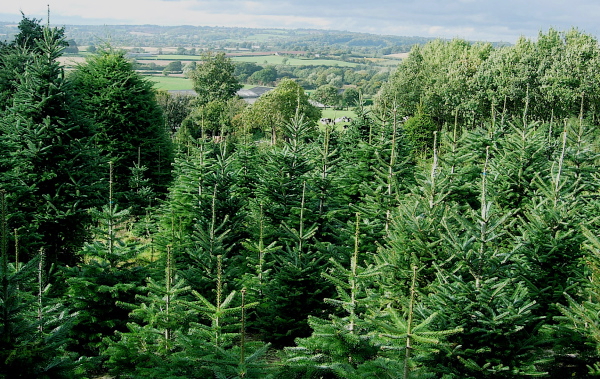
Environmental Benefits
Christmas trees impart huge environmental benefits both as a wildlife habitat and through having a neutral carbon footprint. The UK Carbon Trust calculates that a typical Christmas tree absorbs around 3.5kg CO2 while growing, which then gets released when mulched or burned. Please do not compost or send to landfill as this will release undesirable methane.
At our plantation, we are proud to operate an environmentally sound policy, to produce high quality trees using the minimum of artificial aids, with the aim of encouraging local wildlife including over 40 bird species, plus badgers, foxes, deer and a range of small furry fellas. But for sheer complexity it is the insects which inhabit the crop in the summer before disappearing in the autumn that can be the most fascinating.
Perhaps my favourite is the Greater Horntail: a highly sociable critter which approaches like a sound of a helicopter, lands on your clothing and continues to wander around your person while working in the trees. With its wasp like colouring and inch long ovipositor, it is not for the fainthearted though...
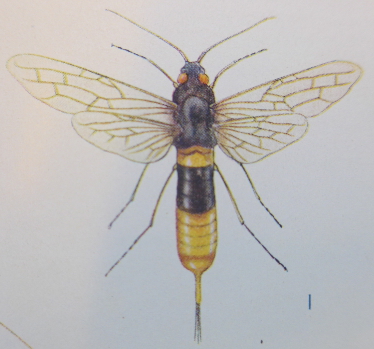
The equally sociable robins are, perhaps, rather less threatening...
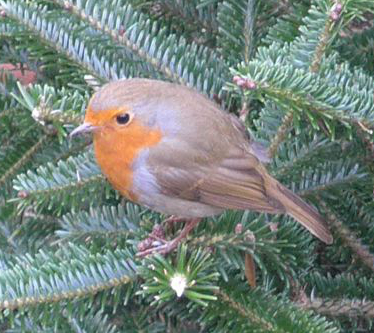
Insects
Aphids and spider mites will cause the trees to become brown if left unchecked. Our policy is control these pests with a single insecticide applied during the winter, when most other insects are hibernating. This means that any insect pests which arrive in the spring or summer are eaten by natural predators. This allows other insects to flourish and provide food for our resident linnets, tits, blackcaps, nuthatches and goldcrests.
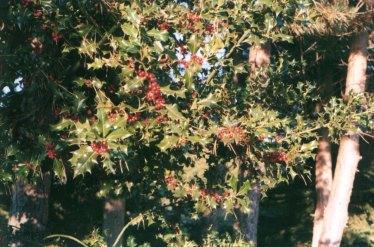
Holly berries. Berries also provide winter food for the birds.
Weeds and Fertiliser
Weeds will cause the trees to become misshapen and brown due to competition for light, nutrients and water. We control our weeds in a narrow strip along the tree rows with highly selective weedkillers which we apply in the winter. In order to improve soil structure and biodiversity, the areas between the rows are being allowed to green up and vegetation will be managed with the mower. If we do need to remove weeds such as thistles or docks in the summer, then this is usually achieved by hand pulling or cutting, or by spot spraying with a non hazardous weeedkiller.
We apply fertiliser only when analysis of the conifer foliage shows that the tree is falling short of particular nutrients. We then correct any nutrient deficiency with carefully selected fertilisers applied to just keep the trees healthy, without allowing surplus nutrients to drain through the soil.
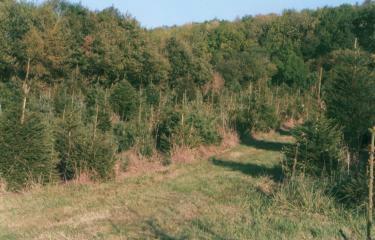
Woodland. We have planted broadleaved trees to add to biodiversity.
Diversity
In our Christmas tree plantation we have self-seeded ash and oak broadleaved trees scattered around the field. These are relished as cover and as perches by many species of birds.
We maintain grassy rides between the blocks of trees. These provide a habitat for field mice, voles and shrews. These small rodents are appreciated by our resident buzzards and kestrels which compete with Willow & Buster (our cats) to grab these tasty morsels.
The plantation is also favoured by our local badgers, who use the specially-constructed badger gates to visit their latrines, or pass through on their nocturnal journeys.
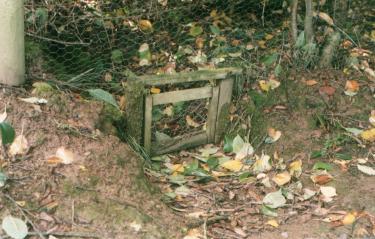
Badger Gate. Hinged at the top, and opened by a push with the snout.
Early summer sees us engage in Operation Duck. Oddly, one or two of our local ducks regard the Christmas trees as an ideal nesting site. This is no problem for them, as they can fly in or out. However, when the ducklings emerge, their frantic mother cannot find a way through the rabbit-proof fencing. It is our role to spot this dilemma and open all the gates whilst preventing the cats from stalking the ducklings.
Autumn sees the start of the shooting season. The local pheasants have cottoned on to the fact that our plantation is a no-go area for the shotgun, and have adopted it as a weekend sanctuary.
The plantation was originally a cider and perry orchard. We have retained three magnificent 150-year-old perry pear trees which provide plenty of insects for our visiting green woodpecker.
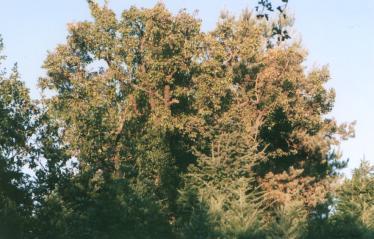
Perry pear trees. These three specimens are now over 150 years old.